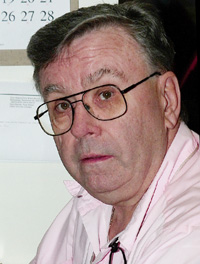
Photo by Paul Walline. |
|
Daniel J. Twohig, information technology (IT) specialist with the Center’s Resource Assessment and Conservation
Engineering (RACE) Division, announced his retirement
effective 30 November 2005 after a 40-year career with the Federal Government. To ascribe to Dan the moniker
“information technology specialist” doesn’t begin to describe the work he accomplished during his career.
Dan started with the Coast and Geodetic Survey in 1966 working as an electronics technician on hydrographic vessels.
This was the beginning of his fascination with ships at sea. He moved to the Bureau of Commercial Fisheries in 1969
as a member of the Gear Research Program at the Montlake Laboratory in Seattle, where he spent a portion of his time
diving in support of the Tuna-Porpoise Program and other bycatch reduction projects.
He joined the developing NMFS fisheries acoustics program in 1970 in Seattle and by 1974 was working full-time with this
program, which is now known as the Midwater Assessment and Conservation Engineering
(MACE) Program.
To document all of Dan’s accomplishments during the course of his career would be nearly impossible in the space
allotted. Some of his more significant accomplishments are mentioned below.
Beginning in 1970, Dan formed part of a collaborative team that included researchers with the UW’s Applied Physics
Lab and Fisheries Research Institute, which developed the world’s first digital collection and analysis system for
quantitative acoustic assessment of fisheries resources.
In 1976, Dan designed and constructed the first NOAA Acoustic Research Container (ARC-1), which was a portable,
self-contained acoustic laboratory housing all of the electronics needed to conduct a fisheries acoustic survey.
The ARC I was used aboard research and chartered commercial vessels during the following 6 years. By 1982, Dan had
implemented his improved acoustic laboratory design by completing the construction of the next generation laboratory,
ARC II. Dan continued to lead the drive during the mid-’90s to redesign and relocate the acoustics laboratory inside
the NOAA ship Miller Freeman to address safety and performance concerns. His resourcefulness and hard work
assured that all three of these temporary homes-at-sea performed flawlessly.
With the acquisition of the Simrad echosounder and processing systems in 1990, Dan rapidly developed his IT skills and
built Ingres and Oracle database systems to handle the acoustic and trawl data for the MACE Program. His efforts to
understand and operate the echosounding systems earned him the respect of technical experts worldwide, particularly in
Norway at Simrad and at the Bergen Institute of Marine Research.
Dan spent 6-8 months at sea each year during much of his career. His extensive knowledge and expertise in acoustics,
technology, ships, and virtually anything electrical or mechanical was invaluable to researchers who had the good
fortune to work with Dan. His shipboard experience led to his assignment as AFSC liaison with the Miller Freeman
during its major repair period in winter 1998-99 and more recently to his role as AFSC representative in the design and
construction of the NOAA ship Oscar Dyson, which is the first in the class of NOAA’s state-of-the-art,
noise-quieted fisheries research vessels.
Dan was honored early in his career as the 1975 NMFS Outstanding Employee of the Year and the 1976 Seattle Federal
Executive Board Employee of the Year in recognition of his substantial contributions to NOAA. He received his first
Department of Commerce (DOC) Bronze Medal for his overall contributions to fisheries assessment in the North Pacific
in 1993. He received three additional DOC Bronze Medals for his efforts in representing AFSC interests with the NOAA
fleet: one for his work with the Miller Freeman in 1999, one for his work on the design of a fleet of new
Fisheries Survey Vessels (FSV) in 2000, and in 2006 for the completion of the first new NOAA fisheries research
vessel Oscar Dyson.
Over the course of his career, it is no exaggeration to say that Dan was involved in most - if not all - significant
milestones within the MACE Program. He was a respected shipmate and mentor to all who sailed and worked with him.
He recently became the proud owner of a new recreational vehicle in which he and his wife Ya Mei plan to tour the
country. We extend Dan a heartfelt thanks from all of us who have had the pleasure and good fortune to work with him
over the years. We wish him all the best in his retirement. He’s earned it!
By Chris Wilson, Neal Williamson, and Gary Stauffer
>>>more
 |

|
OND2005 quarterly sidebar
AFSC Quarterly
Research Reports Oct-Dec 2005
Contents
Feature
ABL Reports
FMA Reports
NMML Reports
RACE Reports
REFM Reports
Milestones
Quarterly Index
Quarterly Home
|

